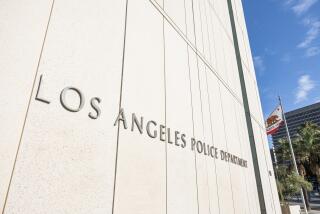LAPD Officer Doctored Documents, Suit Alleges
- Share via
An LAPD anti-gang officer relieved of duty in connection with the ongoing Rampart corruption probe doctored police documents in an effort to frame a young man for a 1996 killing, a federal lawsuit alleges.
Raul Rodriguez, who was acquitted of the murder in 1998, said in a civil rights lawsuit filed this week that LAPD Officer Michael Montoya and other officers fabricated evidence and coerced witnesses in an attempt to frame him for the Nov. 3, 1996, slaying in a bar west of downtown.
Rodriguez is a former 18th Street gang member with a lengthy arrest record. His lawsuit contends that Montoya fabricated an “FI card,”--LAPD vernacular for a field interview card used to document contacts with suspected gang members, drug dealers and other criminals. Specifically, the suit says Montoya “dummied up” the card to make it appear that Rodriguez, who had moved to West Covina, was in his old neighborhood just two nights before the killing.
The card Montoya filled out lacked standard information such as a driver’s license number and Social Security number and listed Rodriguez’s weight as 225 pounds, 35 pounds less than his actual weight, the suit states.
Stephen Yagman, Rodriguez’s civil lawyer, says the reason for the discrepancy in weight is that Montoya filled out the FI card using information from months earlier.
According to the suit, Montoya testified that he saw Rodriguez two nights before the slaying talking with several known gang members and standing next to a black Nissan Sentra, which the officer said belonged to Rodriguez. In fact, Rodriguez had sold the car more than a month before the killing, the suit says.
Moreover, a witness was prepared to testify that Rodriguez was at karate practice in Glendora at the time of the slaying, and would have produced the karate school’s daily roster to support that claim, said William Pitman, the attorney who won Rodriguez’s acquittal. Pitman said that witness was not called because he was not needed.
The suit further alleges that police altered other LAPD documents in an effort to make Rodriguez fit the description of the suspect in the slaying. The gunman, according to witnesses, was known by the gang moniker of “Clever.” The burly Rodriguez went by “Oso,” Spanish for bear.
According to the lawsuit, earlier references to Oso in LAPD documents were amended to read “Oso/Clever,” with “Clever” penned in a different handwriting than “Oso.”
The suit also accuses two homicide detectives assigned to the Rampart Division of manipulating the statements of a cashier at the Fallout Bar so they would match Rodriguez’s physical description.
According to the record of Rodriguez’s trial, his attorney argued that the cashier said the gunman had the numeral 18 tattooed on the side of his neck, signifying membership in the 18th Street gang. Rodriguez has a tattoo on the back of his neck, and the number is spelled out as “eighteen.”
The suit says that, in an application for a warrant to search Rodriguez’s home, the deputies wrote that the cashier described the tattoo as on the side of the neck, not the back.
The warrant allegedly omitted the fact that the cashier repeatedly failed to pick Rodriguez out of a photo lineup presented by the two detectives and in fact insisted that Rodriguez was not the killer when they suggested he was. According to the criminal court file, the cashier pointed to the defendant in at least one photo lineup, saying he resembled the killer but adding that she could not be sure.
Cynthia Rayvis, the deputy district attorney who prosecuted the case, said the cashier had been intimidated to the point that she was afraid to testify against Rodriguez and did not identify him in court. “She wouldn’t even look at him on the stand,” Rayvis said.
Rayvis said she was unable to comment on other details of the case because she did not have access to her file Friday.
Montoya’s attorney, Ira M. Salzman, would not discuss the allegations.
“Due to the always unfolding investigation, it’s best to make no comment now until all the allegations are known,” he said.
According to the lawsuit, a paid police informant also testified that detectives attempted to persuade him to pick Rodriguez out of a photo lineup and to have him sign a statement saying he saw Rodriguez run from the bar seconds after the slaying.
In an effort to rebut that testimony, prosecutors introduced an audiotape interview in which the informant allegedly picked Rodriguez out of the lineup, saying, “That’s him,” according to attorney Pitman.
In the background on the tape, Pitman said, there was a faint clicking sound. He contends that the noise came from one of the detectives tapping a pencil on Rodriguez’s photo, signaling the informant to identify his client.
Despite his acquittal in the slaying, Rodriguez was charged with drug and weapons possession in connection with items seized when detectives searched his home for the murder weapon. He served that sentence and was released from custody on that charge earlier this year.
Rodriguez, a 30-year-old husband and father of three, said he quit his association with the gang about two years before the arrest. He said he had never met Montoya before his arrest and does not know why police would try to frame him for the murder.
As detectives built a case against him, Rodriguez said, he started to fear the worst. “It’s a scary feeling,” he said Friday, noting that defendants are usually convicted. “I didn’t think I was going to win.”
He was so fearful of spending his life in prison, he said, that he considered accepting a plea bargain under which he would have served 10 years. But his attorney discouraged him from taking the offer.
“I’m glad he did,” Rodriguez said.
Nowadays, Rodriguez says his gang associations are long past him. He is enrolled in school, majoring in business administration, and is a metalworker at an aluminum plant.
His case is not the first in which Montoya’s evidence gathering or testimony has been called into question. In October, a defense attorney representing an 18th Street gang member in another murder case accused Montoya of staging a photo of several gang members flashing gang signs outside a popular hangout on Venice Boulevard.
Montoya testified that the photo, which was introduced as evidence during the trial, was taken with the permission of the men in the picture. But the man on trial, Arian Cida, said Montoya and another officer from the CRASH anti-gang unit forced him and the others to be in the picture.
“He made me pose for that. . . . He made me throw 18th Street [signs] with my fingers,” Cida said. He accused Montoya of threatening that if Cida and his friends refused, “he would plant a gun [connected to] a murder on us.”
More to Read
Sign up for Essential California
The most important California stories and recommendations in your inbox every morning.
You may occasionally receive promotional content from the Los Angeles Times.











